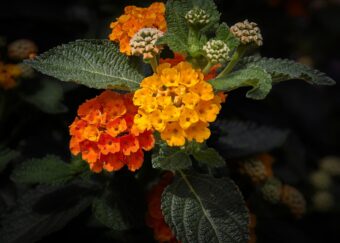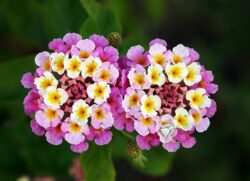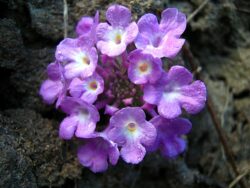In this article, we will discuss how to grow Lantana in containers. If you want an unusual plant that flowers from April to October and is not often seen in the garden, then this shrub is for you.

It is a prolific flowering shrub that makes an ideal plant as long as it is grown in full sun. The flowers are a sight to behold as they often come in different colours that are known to change during the flowering period.
The leaves themselves are distinctive looking and they have wonderful square stems. It can reach heights of 2m or more where they make popular container plants, especially smaller ones.
Lantana is actually a member of the verbena family and native to South America. 150 species are known to exist, where it was brought back to Europe and has been a popular plant ever since. The flowers are very fragrant and will attract insects include butterflies and bees. It is a tender plant and cannot take frosts but by growing in containers you can enjoy the tropical plant all year round.
One of the beauties of these flowers will change with age or have two types of shading, the flowers can be white, pink, yellow, orange, or red. The flowers are followed by spherical, glossy black fruits.
GROWING LANTANA PLANTS IN CONTAINERS
As Lantana grow up to 2m in height you will need a large, sturdy pot to grow it in. I would use a large container for tall species (around a half-barrel standard) and use a 30cm diameter container for dwarf varieties that grow up to a metre in height.
First, as always drill holes to aid drainage and to this add a 70% by volume of multipurpose compost and 30% by volume horticultural grit to help it drain better. To aid drainage even better, you can add a 5cm layer of gravel to the bottom of the container before adding the growing media, as this will help more.
Dig a hole twice the size of the root ball and place the plant level to the depth it was placed in the original container. Backfill with growing media and firm the plant in, ensuring that no gaps remain. Firm the plant in and then water to settle the plant in.
MOISTURE IS THE KEY
You will need to ensure that the plant is moist throughout the year but not soggy, water well when a heatwave is forecasted but never more than what is required. It may take a year for the plant to establish and you must keep your watering up until it has done so.

The plant will become drought resistant after a few months but it needs to be watered frequently until then, especially when 2.5cm below the surface of the compost feels dry. The compost should never be soggy as this will cause root rot. It is best to plant one Lantana per container to avoid overcrowding and also to give better air circulation around the plant.
Fertilizing is not required unless your plant is showing a deficiency in nutrients. In spring, feed with a liquid fertilizer to give a boost during the growing season. No more than one feed should do. Excess fertilizer will result in a straggly plant with few blooms. You can damage the plant by overfeeding.
The plant will need to be deadheaded regularly. Prune back by one-third in mid-spring if it does become straggly.
In early autumn, once nighttime temperatures drop below 10 degrees Celsius, you will need to bring your plant in. Place it in a cool area like a cold frame or greenhouse where it will get sufficient light. If it gets very cold, you may need to cover it with horticultural fleece or you can bring it into a conservatory.
Will not do well in a warm centrally heated home. You must water when 5cm below the surface of the compost feels dry to the touch. Move back outdoors in May when the nighttime temperatures are returning to be above 10 degrees Celsius.
VARIETIES TO GROW
Lantana ‘Chapel Hill’ is a yellow variety of Lantana that has oval, wrinkled, toothed, dark green leaves. It is a compact shrub
Lantana ‘Patriot Rainbow’ is a Lantana with multi-coloured flowers that are a mix of orange, pink and yellow on top of dark green leaves. Part of the Patriot Series include ‘Popcorn’ and ‘Honeyglaze’.

Lantana ‘Denholm White’ is a variety with bright white flowers that contrasts well with the green leaves.
‘ Lantana ‘Pinkie’ is a bicolour variety of Lantana that has pink and cream flowers.
‘Lantana ‘ Weeping White’ is a weeping variety that has white flowers and makes a wonderful hanging basket specimen along with ‘Weeping Lavender’ that produces lavender coloured flowers.
Lantana montevidensis ‘Trailing Lantana’ can grow up to 1m long and has wonderful white or purple flowers.
PESTS AND DISEASES
Lantana will suffer from powdery mildew especially so if grown in a shady, dry area. Best treated with a suitable fungicidal spray,
It can suffer from botrytis when the plant is exposed to excessive moisture. Best to aerate to avoid this.
It will be attacked by whiteflies or other aphids so best treated as soon as these pests are observed. It can also suffer from root rot, so avoid watering too excessively and explains why good drainage is necessary.
CONCLUSIONS
In this article, we have discussed how to grow this wonderful, colourful, scented plant called Lantana in containers. They are generally easy to look after only requiring watering when needed, feeding when required some pruning and protection from frosts.
It is not a common plant to see in the UK, but with my tips, I hope you will be growing some soon.
If you have any questions or comments about growing Lantanas in containers, please do so in the comment box below.
Happy Lantana Growing.
